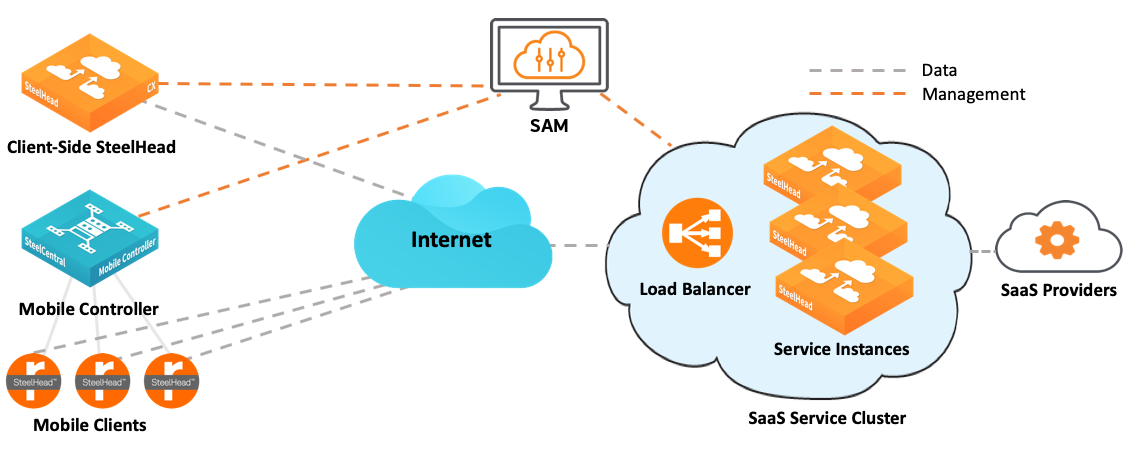Registering the SaaS Accelerator Manager
Riverbed client-side appliances such as SteelHeads, SteelFusion Edges, and Client Accelerator endpoints can accelerate SaaS traffic by working with SaaS Accelerator. Through SaaS Accelerator Manager (SAM), you can configure SaaS applications for acceleration, and then register Riverbed client-side appliances with SaaS Accelerator Manager to accelerate their SaaS traffic.
For Microsoft Teams and Microsoft Stream, SaaS Accelerator requires no additional agent or appliance.
SaaS Accelerator is a service that consists of these components:
• SaaS Application - The application delivered as Software as a Service.
• SaaS Accelerator Manager (SAM) - SAM provides the management interface for SaaS acceleration and manages the acceleration for registered Riverbed client-side appliances. SaaS Accelerator Manager also configures and manages the SaaS service cluster.
• Organization - SAM allows logical separation and segmentation of resources into organizations to support multi-tenant deployments. You can have different organizations to support deployments in different regions. You deploy SaaS Accelerator within an organization.
• Client-side appliances - The client-side appliances located in the customer branch office that intercept any connections destined for the SaaS platform to be accelerated. We strongly recommend that you configure and push SaaS acceleration policies from a SteelCentral Controller for SteelHead (SCC) to managed appliances, particularly in large-scale deployments and production networks with multiple client-side appliances.
• SaaS service cluster - A cluster of service instances behind a service endpoint that peers with client-side appliances. Application acceleration occurs between the client-side appliance and the SaaS service cluster. SAM configures and manages the SaaS service cluster.
• Service instance - The application optimization service node deployed in a SaaS service cluster.
• Client Accelerator endpoints - Client Accelerator endpoints can accelerate SaaS traffic by connecting directly to the SaaS service cluster. Client Accelerator endpoints get their SaaS acceleration configuration through the policy defined in the Client Accelerator Controller.
When you configure a SaaS application for acceleration, SAM deploys a SaaS service cluster in a public cloud to accelerate SaaS traffic. (You do not need a cloud account, and Riverbed configures and manages the SaaS service cluster.) Each SaaS application is accelerated by a dedicated service cluster. For best performance, you need to deploy the SaaS service cluster in the same region as the SaaS application servers.
The service endpoint is the IP address and port range where client-side appliances connect to the SaaS service cluster. You must open multiple ports from 7810 through 7830 on the firewall to allow for this communication.
With SaaS acceleration configured in SAM, the end-user traffic meant for the SaaS server goes to the client-side appliance. The client-side appliance has in-path rules configured that direct the traffic to the SaaS service cluster, and the SaaS service cluster forwards the traffic to the SaaS server. The traffic between the client-side appliances and the SaaS service cluster is accelerated.
For details on configuring and managing SAM, see the SaaS Accelerator Manager User Guide.
SaaS acceleration overview

Registering SAM on the SCC
You can register SAM on the SCC in the Administration > SaaS: SaaS Accelerator Manager Registration page.
To register SAM in the SCC
1. Choose Administration > SaaS: SaaS Accelerator Manager Registration.
2. Complete the configuration as described in this table.
Control | Description |
SaaS Accelerator Manager Hostname | Specify the SAM hostname. |
SaaS Accelerator Manager Port | Specify the SAM port. The default listening port is 3900. |
Registration Token | Specify the registration token. |
Register | Registers SAM on the SCC. |
3. Click Save to Disk.
Configuring system settings
This section describes how to configure system settings to assist you in system administration. This section includes these topics:


